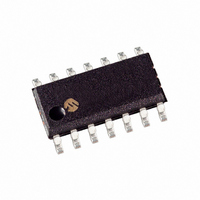HCS473/SL Microchip Technology, HCS473/SL Datasheet - Page 22

HCS473/SL
Manufacturer Part Number
HCS473/SL
Description
IC KEELOQ 3AXIS TRANSCODR 14SOIC
Manufacturer
Microchip Technology
Series
KEELOQ®r
Type
Code Hopping Encoder and Transponderr
Specifications of HCS473/SL
Applications
Access Control Systems
Mounting Type
Surface Mount
Package / Case
14-SOIC (3.9mm Width), 14-SOL
Lead Free Status / RoHS Status
Lead free / RoHS Compliant
HCS473
The HCS473 anticollision method is that all devices
trained to a given vehicle will have the same 12-bit
vehicle identifier (VID); Most Significant 12 bits of the
device identifier, Table 3-3. The device identifier of up
to 16 transponders trained to access a given vehicle
will differ only in the 4 LSb’s. These 4 bits are referred
to as the token identifier (TID).
TABLE 3-3:
The vehicle ID associates the HCS473 with a given
vehicle and the token ID makes it a uniquely address-
able (selectable) 1 of 16 possible devices authorized to
access the vehicle.
Two unique device identifiers are available allowing the
HCS473 to be used with two different vehicles. The
HCS473 responds if the presented VID and TID match
either of the two programmed identifiers.
SELECT TRANSPONDER may still be performed on
devices not configured to require anticollision; commu-
nication can still be isolated to one of multiple devices
in the field. Equally, the same devices will respond to all
command sequences not preceded by the SELECT
TRANSPONDER sequence.
3.2.1.5
Enabling the Proximity Activation configuration option
allows the HCS473 to transmit a hopping code trans-
mission in response to detecting an appropriate wake-
up pulse on an LC input pin.
The HCS473 sends a wake-up sequence Acknowl-
edge in response to detecting the LF field (Figure 3-
11). The device then waits T
edge followed by the normal T
transponder command to begin. If no command is
received, a code hopping transmission is generated
and the minimum code words (set with MTX option) are
transmitted. When the transmission completes, the
HCS473 waits a T
begin. If no command is received the device returns to
SLEEP.
Proximity activations are not repeatedly activated when
the device is in the presence of a continuous LF field
(computer monitor, tv,...). The HCS473 must receive an
appropriate wake-up sequence to activate each trans-
mission.
The button status used in the proximity activated code
hopping transmission clears the S0, S1, S2 and S3 but-
ton status flags.
DS40035C-page 20
15 14 13 12
11 10
9
8
Proximity Activation (PXMA)
16-bit Device ID (DEVID)
11
7
DEVICE ID
CMD
VID
10
6
window for a new command to
9
5
4
8
CMD
CMD
3
7
for the LF field’s falling
6
2
window waiting for a
5
1
0
4
3
3
2
2
TID
1
1
Preliminary
0
0
3.2.1.6
A high Q-factor LC antenna circuit connected to the
HCS473 will continue to resonate after a strong LF field
is removed, slowly decaying. The slow decay makes
fast communication near the reader difficult as the
resulting extended high time makes the following low
time disappear.
The Intelligent damping option enables a pulsed, resis-
tive short from the LC pins to LCCOM when the
HCS473 is expecting the incoming LC signal level to go
low. These pulses damp the antenna, dissipating reso-
nant energy for a quicker decay time when the field is
switched off.
The damping pulses are applied between the LCCOM
pin and the individual LC pins, starting 1.2 LF
detecting the bit’s rising edge and repeating until the
LC input goes low. Damp pulse width is 6 µs, beginning
every 44 µs as shown in Figure 3-9.
FIGURE 3-9:
3.2.1.7
HCS473 responses may optionally be returned on the
DATA pin for long-range RF responses and/or LC pins
for short-range LF responses (Table 3-4). Responses
include both Acknowledge sequences and data
responses.
The options controlling the response path are:
• LC response option (LCRSP)
• RF response option (RFRSP)
If both RF and LF responses are enabled, Acknowl-
edge pulses will occur simultaneously on the DATA and
LC pins; using the LF
Figure 3-19). Data responses will not occur simulta-
neously. The RF response on the DATA pin will occur
first (following the designated Encoder mode format),
immediately followed by the LF response on the LC
pins (Figure 3-20).
Note:
Signal
LC Output
Field on
LC pins
Level
Damping will not reduce the HCS473 inter-
nal LF analog filter discharge time, T
(Section 3.2.6).
Intelligent Damping (DAMP)
Response Options (RFRSP,
LCRSP)
No Damping
INTELLIGENT DAMPING
2002 Microchip Technology Inc.
T
TE
DAMP
baud rate (Figure 3-11,
With Damping
Damping Pulses
TE
FILTF
from













